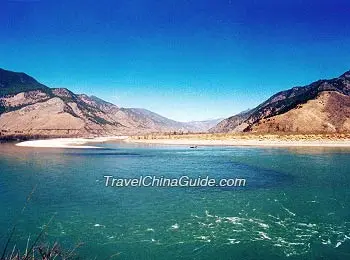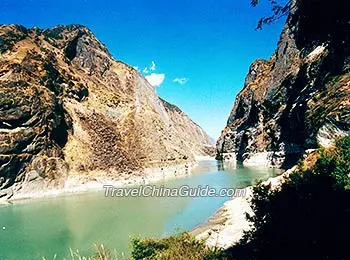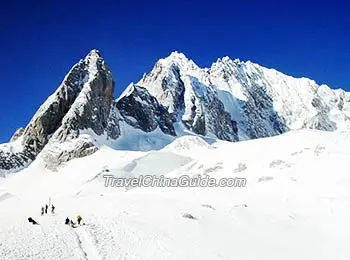In the 1980s, an expert at the United Nations found a marvelous natural scene on a satellite map of the Northern Hemisphere. In the northwest area of Yunnan Province, there are three rivers flowing parallel from the Qinghai-Tibet Plateau to the south, but never converge. This is the 29th project of the World's Cultural and Natural Heritage in China, Three Parallel Rivers of Yunnan Protected Areas.
 | | The First Bend of the Yangtze River | |  | | Hutiao Valley, Yunnan | |
Originating in the Tanggula Mountain on the Qinghai-Tibet Plateau, the Jinsha River, Lancang River and Nu River flow parallel along the Hengduan Mountains for several hundred kilometers. It is a very rare phenomenon that the shortest distance between the Lancang River and Jinsha River is only 66 kilometers (about 41 miles) and between the Lancang River and Nu River the distance is less than 19 kilometers (about 12 miles). Interestingly, their entrances to different seas are thousands of kilometers away.
This protected area covers Nu Jiang Lisu Autonomous Prefecture, Diqing Tibetan Autonomous Prefecture and Lijiang District. The Three Parallel Rivers have spectacular scenery that is composed of the rivers, mountains, rare plants, animals and 16 ethnic groups' inhabitation.
In this protected area, you can see the typical topographic feature of Yunnan, comprised of the wonderful view of the parallel rivers, high mountains and deep gorges. The height of snow-covered mountains in this area varies from 2,000 meters (about 6562 feet) to 6,000 meters (over 19,600 feet), and there are over 100 snow-covered mountains higher than 5, 000 meters (over 16, 400 feet). Among them, the most famous one is the
Meili Snow Mountain, which is regarded as a Holy Mountain by the local Tibetan People.
 | | The Jade Dragon Snow Mountain | |  | | Lijiang Dongba Wanshen Park | |
Correspondingly, the gorges are very deep. Nu River Gorge, Lancang River Gorges and Jinsha River Gorges are particularly famous. The average depth of Nu River Gorge is 2,000 meters (about 6562 feet) and it was so named 'the Oriental Grand Gorge'. The famous
Tiger Leaping Gorge , which is a part of Jinsha River Gorge, is the deepest gorge of the world. The gorge bottom consists of the subtropical climate, dry and hot, while half way up the mountains it is cool and pleasant. The summits of the mountains are covered with snow all year round. Within the height of several thousand meters, the climate and natural landscape change greatly.
Due to vertical climate differences, there are 20% Higher Plants and over 25% more animals in this area. Some rare plants and animal can also be found here, such as Yunnan golden monkeys, antelopes, snow leopards, Bengalese tigers and black necked cranes.
The protected area of the Three Parallel Rivers is also a region inhabited by 16 different ethnic groups. It is a peculiar place where multi-ethnic groups, different languages, various religions, cultures and manners and customs co-exist. The place where the Naxi Dongba Religion culture originated,
Baishui Tableland and the
Lijiang Old Town , as well as the
Mosuo People which has the characteristic of a matriarchal society attract numerous visitors from all over the world.
The protected area of the Three Parallel Rivers has great value in science, aesthetics and a unique culture of ethnic groups. It is a stirring attraction for scientists, explorers and visitors world wide.
How to get to Three Parallel Rivers of Yunnan Protected Areas
Visitors need to get to Liuku Bus Station in Nujiang Lisu Autonomous Prefecture first, and then they can take bus from there to Fugong or Gongshan. This itinerary gives visitors a chance to explore the Nu River Gorge.
From Kunming
Visitors can take regular bus from Kunming West Bus Station to Liuku. Buses depart at 10:00, 14:30, 20:00. It takes around 9 hours.
From Lijiang
Take bus from Lijiang Bus Station to Liuku at 09:00, which takes 6-7h. Then, follow the above-mentioned route.
From Dali
Take a bus from the Express Bus Station (near Longxi Road Crossing) to Liuku. Buses are available from 09:20, 12:20 and 14:40 and it takes about 4-5h. Or take a bus at Dali Bus Station at 08:40, 11:50 and 14:10 to Liuku.
- Last updated on Aug. 15, 2025 by Demi Li -



